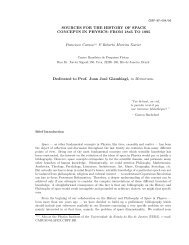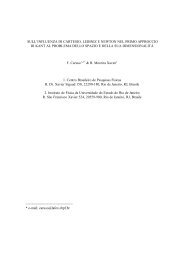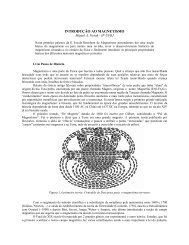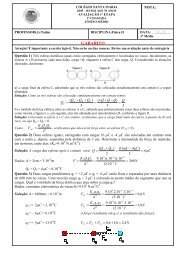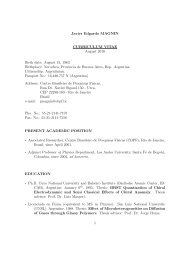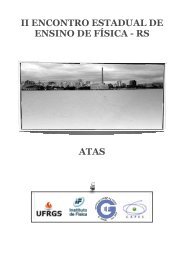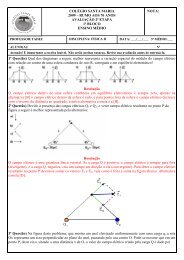Primordial non-Gaussianity in the cosmological perturbations - CBPF
Primordial non-Gaussianity in the cosmological perturbations - CBPF
Primordial non-Gaussianity in the cosmological perturbations - CBPF
You also want an ePaper? Increase the reach of your titles
YUMPU automatically turns print PDFs into web optimized ePapers that Google loves.
Part I<br />
Introduction<br />
Our current understand<strong>in</strong>g of <strong>the</strong> evolution of <strong>the</strong> universe is based upon <strong>the</strong> Friedmann-Robertson-<br />
Walker (FRW) <strong>cosmological</strong> model, or <strong>the</strong> hot big bang model as it is usually called. The model is<br />
so successful that it has become known as <strong>the</strong> standard cosmology. times. The FRW cosmology is<br />
so robust that it is possible to make sensible speculations about <strong>the</strong> universe at times as early as<br />
10 −43 sec after <strong>the</strong> Big Bang.<br />
The most important feature of our universe is its large scale homogeneity and isotropy. This<br />
feature ensures that observations made from our s<strong>in</strong>gle po<strong>in</strong>t are representative of <strong>the</strong> universe as a<br />
whole and can <strong>the</strong>refore be legitimately used to test <strong>cosmological</strong> models. For most of <strong>the</strong> twentieth<br />
century, <strong>the</strong> homogeneity and isotropy of <strong>the</strong> universe had to be taken as an assumption, known as<br />
<strong>the</strong> Cosmological Pr<strong>in</strong>ciple. The assumption of isotropy and homogeneity dates back to <strong>the</strong> earliest<br />
work of E<strong>in</strong>ste<strong>in</strong>, who made <strong>the</strong> assumption not based upon observations, but as <strong>the</strong>orists often do,<br />
to simplify <strong>the</strong> ma<strong>the</strong>matical analysis. The Cosmological Pr<strong>in</strong>ciple rema<strong>in</strong>ed an <strong>in</strong>telligent guess<br />
until firm empirical data, confirm<strong>in</strong>g large scale homogeneity and isotropy, were f<strong>in</strong>ally obta<strong>in</strong>ed<br />
at <strong>the</strong> end of <strong>the</strong> twentieth century. The best evidence for <strong>the</strong> isotropy of <strong>the</strong> observed universe<br />
Figure 1: The large-scale structure from <strong>the</strong> 2dF Galaxy Survey<br />
is <strong>the</strong> uniformity of <strong>the</strong> temperature of <strong>the</strong> cosmic microwave background (CMB) radiation: aside<br />
from <strong>the</strong> observed dipole anisotropy, <strong>the</strong> temperature difference between two antennas separated by<br />
angles rang<strong>in</strong>g from about 10 arc seconds to 180 ◦ is smaller than about one part <strong>in</strong> 10 5 . The simplest<br />
<strong>in</strong>terpretation of <strong>the</strong> dipole anisotropy is that it is <strong>the</strong> result of our motion relative to <strong>the</strong> cosmic rest<br />
frame. If <strong>the</strong> expansion of <strong>the</strong> universe were not isotropic, <strong>the</strong> expansion anisotiopy would lead to a<br />
temperature anisotiopy <strong>in</strong> <strong>the</strong> CMBR of similar magnitude. Likewise, <strong>in</strong>homogeneities <strong>in</strong> <strong>the</strong> density<br />
of <strong>the</strong> universe on <strong>the</strong> last scatter<strong>in</strong>g surface would lead to temperature anisotropies. In this iegard,<br />
6




